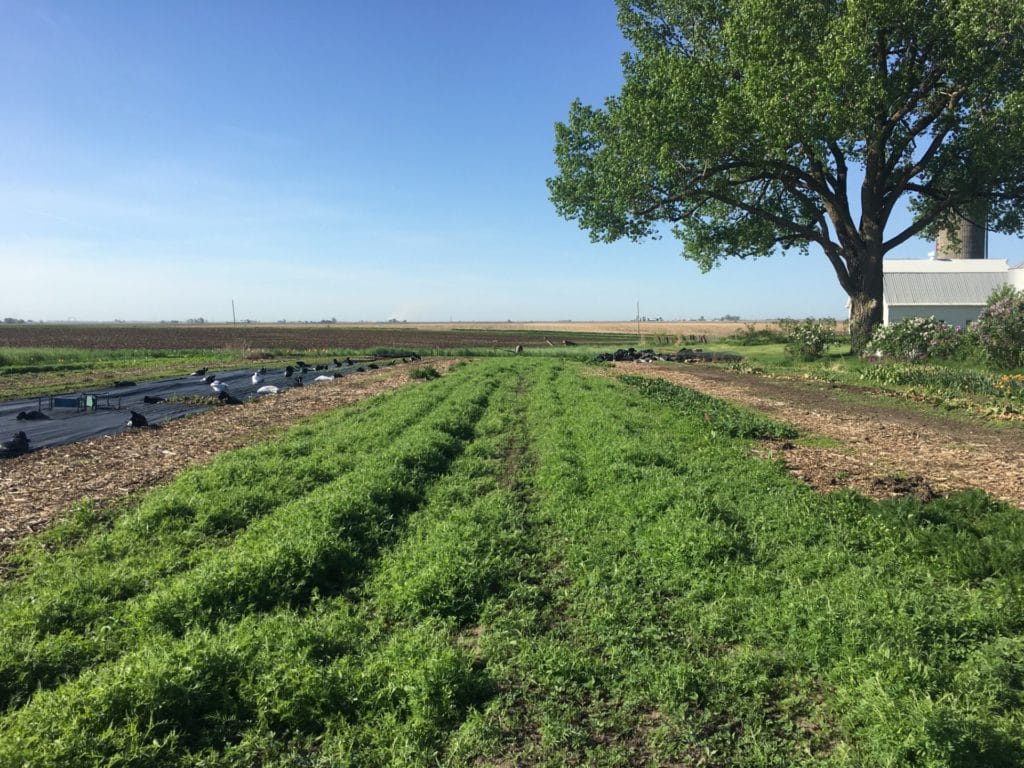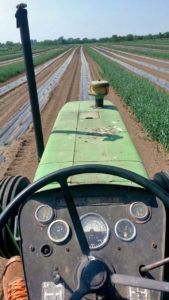Cover Crop Stories
A trio of tales shows how horticulture farmers use cover crops in sometimes creative and surprising ways.
In any annual cropping system, cover crops provide a host of benefits. Their ability to curb weeds, halt erosion and improve soil health are some of their more well-known attributes. But for some horticulture farmers, the benefits of cover crops show up in special ways. The stories that follow reveal some of these surprising and creative cover crop applications.
Sunflower Sentries
Downy white puffs swirled through the air at Lutheran Services in Iowa’s Global Greens Farm in West Des Moines, Iowa. But these were not welcome winter snowflakes. It was July, and these puffs were noxious. Near the property’s edge, adjacent to neighboring homes, invasive Canada thistles had overtaken an unplanted area, grown tall and gone to seed, billowing silky fluff across the neighborhood. And the calls flooded in.
“The neighbors were complaining,” says Jennie Erwin, farm manager for Global Greens. So she dug into her cover crop toolbox for a solution. Buckwheat is usually near the top. It’s easy to manage, grows fast, is good for pollinators and works well in small spaces. But Jennie didn’t think “friendly, flexible” buckwheat, as she describes it, would be robust enough against the tenacious thistles.
She also relies on multispecies mixes for their various benefits – like a peas-and-oats combo in early spring. The peas put nitrogen, a key nutrient, back in the soil, while the oats outcompete many weed species. For rehabilitating soil over a longer time, including over winter, Jennie likes blending rye and hairy vetch. In this pairing, the rye brings the weed suppression, and the vetch boosts nitrogen.
But she didn’t think either combo could successfully best the battalion of thistles that had taken hold. So she decided to try a new cover crop ally: sunflowers. Jennie doesn’t recall exactly where she heard about using sunflowers to suppress weeds. But the idea intrigued her. “I probably got the idea from some research report or another from PFI or ISU [Iowa State University],” Jennie says. “I just wondered what other plant options there were for controlling aggressive weeds.”
The tall, sturdy sunflower sentries have done their job superbly. This year marks her third trialing sunflowers as a thistle deterrent – and the word she uses to describe their effect is thorough. Areas once crammed with Canada thistle now have zero where sunflowers successfully established. “When I got in the sunflowers to look, the understory was just a completely different array of species,” Jennie says. “There are some low-growing weeds surviving the low light and allelopathy [chemical suppression] from the sunflowers, but nothing as noxious as thistles.”
Yet Jennie recognizes that it’ll take time to oust the hardy thistles. “The rhizomes are still in there,” she says, referring to the thistles’ underground root structures that can persist for five years or more. “I don’t know how many years I’ll have to keep it up. But so far, I feel like we’re winning. I also know that neighbors like the sunflowers a lot better than the thistles.”
Cover Crop Bouquets
It’s early spring, and hairy vetch blankets the flower fields at Barnswallow Flowers in Oskaloosa, Iowa, where Meredith Nunnikhoven grows and sells bouquets, tubers and bulbs. By June, the vetch will burst with purple and white flowers. While noted as a durable cover crop that nourishes the soil, the blooms are a boon to bees – and Meredith’s floral bouquets.
Meredith likes to plant hairy vetch or its cousin, phacelia, in the fall after she’s cleared her flower production beds. Both are staple cover crop species that overwinter, thrive in the cool spring and “are great nitrogen fixers,” Meredith says. “And we use buckwheat in a summer rotation as well.”
Floral bouquets are a signature product at Barnswallow Flowers, and when Meredith looks at her cover crops, she sees more than soil benefits. Cover crop greenery and flowers often show up in her bouquets. “White and pink buckwheat flowers show up in our arrangements, along with hairy vetch, phacelia and cress,” Meredith says. “Even rye and winter wheat have made it into bouquets.”
Meredith’s use of the beauty around her shows her creativity as a flower farmer. But stewarding the soil on her land is a role Meredith takes seriously.
“In the past five years, we’ve had little rain, and cover crops helped us farm in a sustainable way,” she says. “We just try to have the ground covered and growing something as much of the year as possible.”
Fences Buried by Time
Long ago, near Conesville, Iowa, a field scoured by sandy wind came to house three fences stacked one on top of the
other. Jordan Lyon, of Buser’s Produce, relates the tale that’s now passed into local legend. Years back, he says, a young boy helped his father build the first fence to enclose the field for grazing cattle. But the soil around Conesville, which lies between the Cedar and Iowa rivers, is sandy and loose, and over time the wind blew the soil against the fence until the cattle could step right over it.
So the boy, now in high school, helped his father build a second fence right atop the first. The high schooler grew into a man and came to own the field. And the wind still blew. When the second fence was nearly covered, the man added a third to keep the cattle in. Eventually, the land sold and the cattle grazed no more. The fences were removed and the soil was respread. The man grew old and his story spread to others in town, the details fading into fable.
Jordan tells the story of the buried fences as a potent parable about the value of cover crops at Buser’s Produce, where he grows up to 60 acres of melons with his farm partner. Rich Buser. The
old man is now gone, but the wind still blows the sandy soil. That’s why Jordan plants a new kind of fence around his melon crops: a cereal rye cover crop. “It’s like a mini windbreak for our soil,” he says. “Our topsoil isn’t very good, and we want to keep what we have in the right spot.”
In their windswept river valley, Jordan and Rich plant rye in the fall on as many acres as possible to anchor their soil through the winter. Come spring, Jordan marks off 50-foot-wide sections where he discs the rye into the soil. He then lays irrigation lines, covers them with black plastic and plants melons into the plastic. But between each section, he leaves 7-foot-wide strips of rye to stand guard throughout the season – living fences to catch the soil and spin a new story about a more resilient farm.
Were it not for his farm’s sandy soil, Jordan says he’d consider planting rye across the whole field. “The sandy soil makes irrigation necessary,” he says, “and running the irrigation lines through the rye would be hard.” But integrating rye as he and Rich have done still helps in many ways. The standing rye not only holds the soil in place but also protects the melon plants from wind damage, which could invite disease.
When worked into the soil, the rye also adds nutrients that help support plant health. “Healthy plants will fight off disease pretty well,” Jordan says. “But when you’ve sucked everything out of that soil and don’t put nutrients back, you end up with issues like disease.” Drip irrigation helps here too by reducing the risk of disease from too much water on plant leaves, as overhead irrigation could cause.
But Jordan says cover crops play a key role at Buser’s Produce. “I can’t point to a single practice and say, ‘That’s worth 5 bushes.’ But cover crops are an important tool for us.
They [cover crops] protect our soil, and if we don’t have soil, we’re not farming anymore.”






